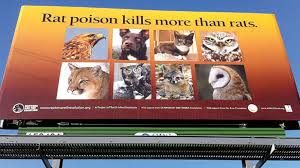10
May
Research Assesses Ability of Rodent Poisons to Act as a “Super-Predator” in Ecosystems
 (Beyond Pesticides, May 10, 2018) Rodenticides like bromadiolone, used to kill vole populations on farms, act like “super-predators” that imperil ecosystem health, according to preliminary results published by researchers working for the European Union. “Controlling voles with bromadiolone reduces the amount of food available to predators and increases their risk of secondary poisoning when they eat the contaminated rodents,” project researcher Javier Fernandez de Simon, PhD, said in a press release. The study provides a model that may alleviate the impact of rodenticide use and provide a balance between on-farm pest management and sustainability.
(Beyond Pesticides, May 10, 2018) Rodenticides like bromadiolone, used to kill vole populations on farms, act like “super-predators” that imperil ecosystem health, according to preliminary results published by researchers working for the European Union. “Controlling voles with bromadiolone reduces the amount of food available to predators and increases their risk of secondary poisoning when they eat the contaminated rodents,” project researcher Javier Fernandez de Simon, PhD, said in a press release. The study provides a model that may alleviate the impact of rodenticide use and provide a balance between on-farm pest management and sustainability.
There are several types of rodenticides available on the market, including acute poisons like strychnine, fumigants like phosphine gas, and anti-coagulants such as warfarin and bromadiolone. Anti-coagulants, the focus of the present study, work by blocking the ability of the body to form blood clots. Animals exposed to bromodialone and other anti-coagulants experience ruptured blood vessels, hair loss and skin damage, nosebleeds, and bleeding gums prior to death. These pesticides are generally applied through secured bait boxes that only allow rodent pests to feed, however secondary poisoning is a common occurrence, leading researchers to dub these rodenticides, in effect, as “super-predators.”
Rodents that ingest anti-coagulant pesticides are not killed outright, and can be easy prey for animals up the food chain, particularly owls, raptors, foxes, coyotes, and small mustelids like the stoats and weasels observed in the current study. To reveal this occurrence in the wild, researchers set up monitoring stations around rodenticide-treated and untreated sites where weasels and stoats frequent during the growing season. While the population of mustelids remained relatively unchanged at untreated sites, treated sites experienced notable declines. “As small mustelids can consume dead voles and we only found rodenticide residues in voles and small mustelid droppings from treated sites, we concluded that application of anticoagulant rodenticides in grasslands may generally reduce the abundance of small mustelids,” said Dr. Fernandez de Simon.
Using a model, researchers found that anti-coagulant rodenticides were most destructive to other animals, acting most like “super-predators,” when populations of target voles were lower than 50 voles per hectare. However, when the model was adjusted and these poisons were applied in low quantities when vole populations were higher – 250 voles per hectare – predator populations were still able to grow, and successfully regulate vole populations by themselves. “This treatment protocol could reduce the impact of rodenticides on predator numbers, while maintaining relatively low densities of voles, thereby benefitting farmers’ interests,” Dr. Fernandez de Simon said.
Anti-coagulant rodenticides garnered public attention for the 2014 poisoning of a charismatic mountain lion named P-22, which frequents the “Hollywood” sign in California. Use of rodenticides in illegal marijuana grow operations has led to consideration of protected status for populations of fishers on the west coast. Many groups on the West Coast are working to replace the use of rodenticides with greater ecological diversity, and better preventative practices. Poison Free Malibu, which presented at Beyond Pesticides 36th National Pesticide Forum, is pushing for the passage of California bill AB 2422, which would restrict the use of anticoagulant rodent poisons throughout the state.
For more information on managing rodent problems without toxic, “super-predator” rodenticides, see Beyond Pesticides ManageSafe webpage. And to promote on-farm reduction of anti-coagulant rodenticides, support organic agriculture, which doesn’t allow this type of rodent poison, and requires any measure addressing rodent pests be guided by a pre-determined organic systems plan.
All unattributed positions and opinions in this piece are those of Beyond Pesticides.
Source: European Commission Community Research and Development Information Service










